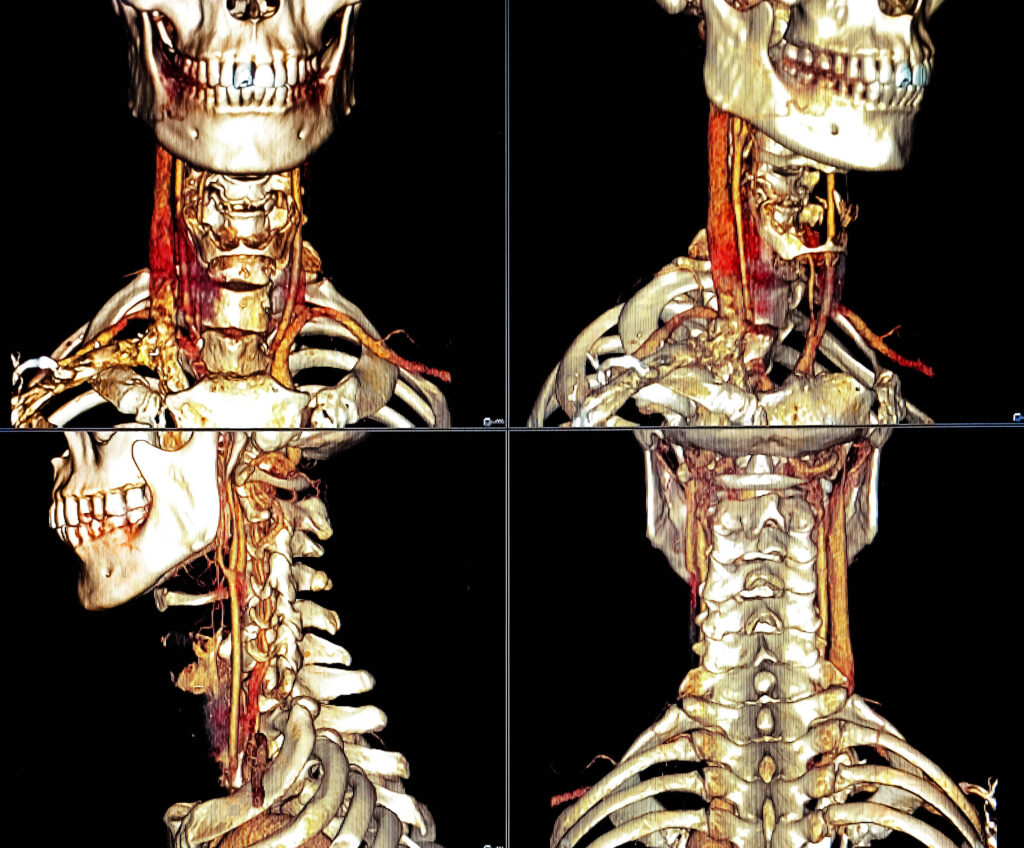
Suggestive of Neck Ct scan seen right side problem. 3D reconstruction of neck ct contrast media.
PROVIDENCE, R.I. – A startling increase in strokes linked to cervical artery dissections has been identified in a new nationwide study, raising alarms about a largely unrecognized cause of ischemic strokes. The study, led by Dr. Shadi Yaghi, a vascular neurologist at Brown University, analyzed 125,102 hospital records, revealing a 400% rise in related hospital stays from 2005 to 2019.
Immediate Impact of Cervical Artery Dissections
Cervical artery dissection occurs when the inner lining of a neck artery splits, allowing blood to create a flap that can slow flow or form a clot, leading to a stroke. This condition is a significant concern for adults under 50, accounting for up to one in four strokes in this age group. The dissections often follow trauma such as car accidents or sports injuries, yet even minor incidents like reaching awkwardly can trigger them.
400% increase in hospital stays due to cervical artery dissections from 2005 to 2019.
Key Details Emerge in Detection and Diagnosis
Advancements in ultrasound and magnetic-resonance imaging have improved the detection of cervical artery dissections, revealing tiny mural bruises previously missed by older technology. This has contributed to both a real increase in cases and better diagnostic capabilities.
Recognizing the Symptoms
Emergency clinicians are trained to identify the classic symptoms: sudden one-sided headache or neck pain, sometimes accompanied by a droopy eyelid. Patients may also experience a pulsing “whoosh” in one ear, indicating turbulent blood flow past the tear.
Computed tomography angiography is now the preferred first test in young stroke patients, mapping blood flow in minutes.
By the Numbers: Rising Incidence and Disparities
The incidence of cervical artery dissections has climbed from 11 to 46 cases per million people over 15 years, with an average annual increase of 10%. Hispanic and Black Americans have experienced the steepest rises, nearly doubling the increase seen in white patients. This suggests disparities in trauma exposure and access to early vascular care.
Incidence increased by 10% annually, with notable disparities among racial groups.
Expert Analysis: Understanding the Causes
Dr. Yaghi emphasizes the importance of early diagnosis, noting that strokes, while not always fatal, can lead to long-term disability and reduced quality of life. The sharpest rise in cases occurred among those over 65, possibly due to age-related vessel changes and more liberal imaging practices.
Link to Physical Activities
Sports medicine literature associates dissections with activities like wrestling, surfing, and yoga, which can force the neck beyond its normal range. A case report highlighted a 34-year-old woman’s fatal stroke following chiropractic manipulation, underscoring the need for caution.
What Comes Next: Treatment and Prevention
Current guidelines recommend starting antiplatelet drugs like aspirin for three to six months, with anticoagulants reserved for more complex cases. Endovascular stenting is considered for repeat attacks resistant to medication.
Tele-stroke clinics are improving access to follow-up care, potentially reducing racial disparities in treatment outcomes.
Lowering the Risk
- Wear a seat belt and adjust the headrest to eye level.
- Avoid twisting the neck while lifting heavy objects.
- Secure loose cargo to prevent sudden reaching while driving.
Researchers are exploring new treatments and diagnostic tools, such as direct oral anticoagulants and ultrasound markers, to identify weak arteries before they fail. Genetic studies are also underway to uncover insights into connective-tissue biology related to this condition.
The study’s findings, published in Neurology, highlight the urgent need for awareness and preventive measures to combat the rising threat of cervical artery dissections.
—
For more in-depth articles and the latest updates, subscribe to our newsletter. Explore EarthSnap, a free app by Eric Ralls and Earth.com, for more engaging content.







